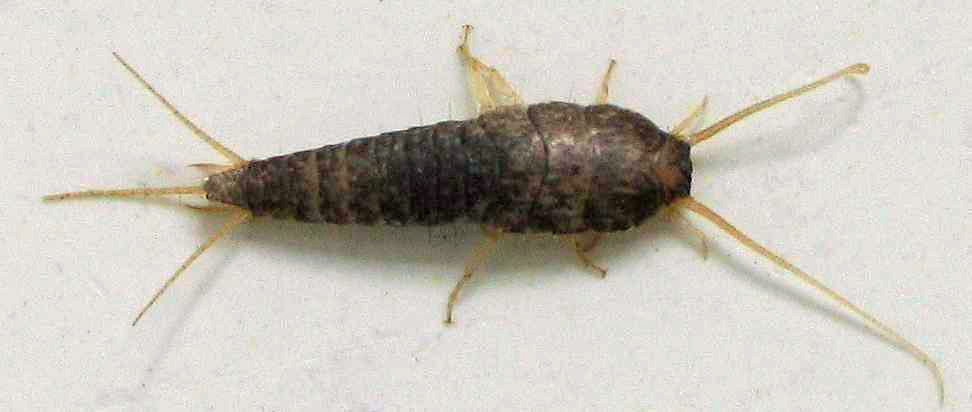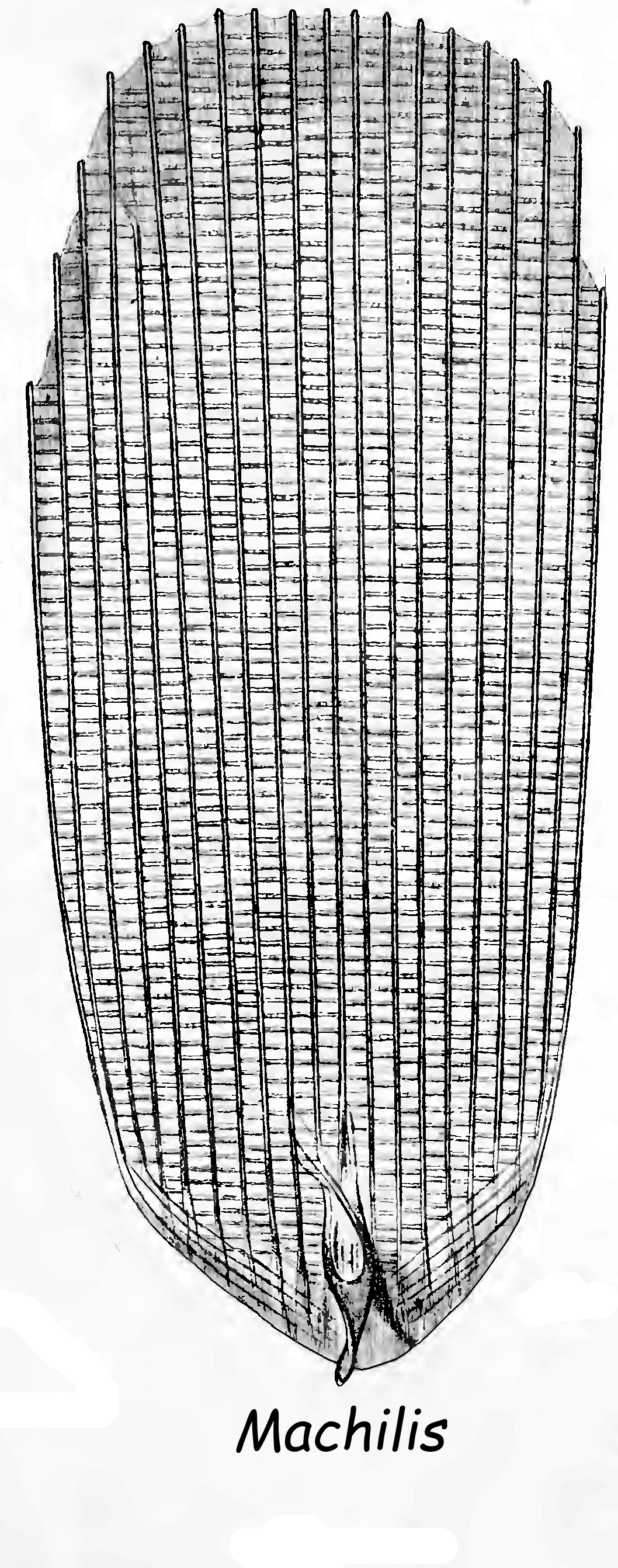|
Tricholepidiidae
''Tricholepidion'' is a genus of wingless insect belonging to Zygentoma (silverfish and allies), with only a single described species ''T. gertschi'', native to the northern coast of California in Western North America. It lives under dead bark and in rotting wood of conifers in mesophytic forests. It is alternatively considered the only living member of the family Lepidotrichidae, which also includes '' Lepidotrix'' from Eocene aged European amber, or the only member of the family Tricholepidiidae. The taxonomic position of ''Tricholepidion'' is uncertain, in some molecular phylogenetics studies it has been recovered as less closely related to flying insects (Pterygota) than the rest of Zygentoma is, rendering Zygentoma paraphyletic. Each compound eye contains ~40 ommatidia, and they have three ocelli. Scales on the body are absent. Unlike Archaeognatha The Archaeognatha are an order of apterygotes, known by various common names such as jumping bristletails. Among extant ins ... [...More Info...] [...Related Items...] OR: [Wikipedia] [Google] [Baidu] |
Zygentoma
Zygentoma are an order in the class Insecta, and consist of about 550 known species. The Zygentoma include the so-called silverfish or fishmoths, and the firebrats. A conspicuous feature of the order are the three long caudal filaments. The two lateral filaments are cerci, and the medial one is an epiproct or ''appendix dorsalis''. In this they resemble the Archaeognatha, although the cerci of Zygentoma, unlike in the latter order, are nearly as long as the epiproct. Until the late twentieth century the Zygentoma were regarded as a suborder of the Thysanura, until it was recognized that the order Thysanura was paraphyletic, thus raising the two suborders to the status of independent monophyletic orders, with Archaeognatha as sister group to the Dicondylia, including the Zygentoma. Etymology The name "Zygentoma" is derived from the Greek ('), in context meaning "yoke" or "bridge"; and ('), "insects" (literally meaning "cut into", in reference to the segmented anatomy o ... [...More Info...] [...Related Items...] OR: [Wikipedia] [Google] [Baidu] |
Lepidotrichidae
Lepidotrichidae is a family of basal insects belonging to the order Zygentoma ( silverfish and allies). The family contains the extinct '' Lepidotrix'', known from specimens preserved in Eocene-aged European amber. The extant Extant or Least-concern species, least concern is the opposite of the word extinct. It may refer to: * Extant hereditary titles * Extant literature, surviving literature, such as ''Beowulf'', the oldest extant manuscript written in English * Exta ... genus '' Tricholepidion'', which contains a single species, '' Tricholepidion gertschi'' from western North America, has also been typically considered a member of the family. However, more recent research suggests that the two genera are not particularly closely related, and ''Tricholepidion'' should instead be assigned to its own family Tricholepidiidae. References External linksLepidotrichidae.Integrated Taxonomic Information System (ITIS). Insect families Taxa named by Filippo Silvestri {{ ... [...More Info...] [...Related Items...] OR: [Wikipedia] [Google] [Baidu] |
Silverfish
The silverfish (''Lepisma saccharinum'') is a species of small, primitive, wingless insect in the order Zygentoma (formerly Thysanura). Its common name derives from the insect's silvery light grey colour, combined with the fish-like appearance of its movements. The scientific name (''L. saccharinum'') indicates that the silverfish's diet consists of carbohydrates such as sugar or starches. While the common name ''silverfish'' is used throughout the global literature to refer to various species of Zygentoma, the Entomological Society of America restricts use of the term solely for ''Lepisma saccharinum''. Description The silverfish is a nocturnal insect typically long. Its abdomen tapers at the end, giving it a fish-like appearance. The newly hatched are whitish, but develop a greyish hue and metallic sheen as they get older. It has two long cerci and one terminal filament at the tip of the abdomen between the cerci. It also has two small compound eyes, although other members ... [...More Info...] [...Related Items...] OR: [Wikipedia] [Google] [Baidu] |
Mesophyte
Mesophytes are terrestrial plants which are adapted to neither particularly dry nor particularly wet environments. An example of a mesophytic habitat would be a rural temperate meadow, which might contain goldenrod, clover, oxeye daisy, and '' Rosa multiflora''. Mesophytes prefer soil and air of moderate humidity and avoid soil with standing water or containing a great abundance of salts. They make up the largest ecological group of terrestrial plants, and usually grow under moderate to hot and humid climatic regions. Morphological adaptations Mesophytes do not have any specific morphological adaptations. They usually have broad, flat and green leaves; an extensive fibrous root system to absorb water; and the ability to develop perennating organs such as corms, rhizomes and bulbs to store food and water for use during drought. Anatomical adaptations Mesophytes do not have any special internal structure. Epidermis is single layered usually with obvious stomata. Opening or closing o ... [...More Info...] [...Related Items...] OR: [Wikipedia] [Google] [Baidu] |
Lepidotrix
''Lepidotrix'' is an extinct genus of wingless insect belonging to Zygentoma (silverfish and allies) in the family Lepidotrichidae. There is one described species in ''Lepidotrix'', ''L. piliferum/pillifera''. It is known from specimens found in Eocene aged Baltic amber and Rovno amber. The genus lacks occelli. Its relationship with the extant genus ''Tricholepidion,'' which has historically been placed in the same family, is disputed, with some studies finding the two taxa to not be closely related, with ''Tricholepidion'' being placed in its own family instead. While often spelled ''Lepidothrix'' in historic literature, this is homonymous In linguistics, homonyms are words which are either; ''homographs''—words that mean different things, but have the same spelling (regardless of pronunciation), or ''homophones''—words that mean different things, but have the same pronunciatio ... with a genus of birds, and ''Lepidotrix'' was the spelling used in the original publica ... [...More Info...] [...Related Items...] OR: [Wikipedia] [Google] [Baidu] |
Eocene
The Eocene ( ) is a geological epoch (geology), epoch that lasted from about 56 to 33.9 million years ago (Ma). It is the second epoch of the Paleogene Period (geology), Period in the modern Cenozoic Era (geology), Era. The name ''Eocene'' comes from the Ancient Greek (''Ēṓs'', 'Eos, Dawn') and (''kainós'', "new") and refers to the "dawn" of modern ('new') fauna that appeared during the epoch.See: *Letter from William Whewell to Charles Lyell dated 31 January 1831 in: * From p. 55: "The period next antecedent we shall call Eocene, from ήως, aurora, and χαινος, recens, because the extremely small proportion of living species contained in these strata, indicates what may be considered the first commencement, or ''dawn'', of the existing state of the animate creation." The Eocene spans the time from the end of the Paleocene Epoch to the beginning of the Oligocene Epoch. The start of the Eocene is marked by a brief period in which the concentration of the carbon isoto ... [...More Info...] [...Related Items...] OR: [Wikipedia] [Google] [Baidu] |
Molecular Phylogenetics
Molecular phylogenetics () is the branch of phylogeny that analyzes genetic, hereditary molecular differences, predominantly in DNA sequences, to gain information on an organism's evolutionary relationships. From these analyses, it is possible to determine the processes by which diversity among species has been achieved. The result of a molecular phylogenetics, phylogenetic analysis is expressed in a phylogenetic tree. Molecular phylogenetics is one aspect of molecular systematics, a broader term that also includes the use of molecular data in Taxonomy (biology), taxonomy and biogeography. Molecular phylogenetics and molecular evolution correlate. Molecular evolution is the process of selective changes (mutations) at a molecular level (genes, proteins, etc.) throughout various branches in the tree of life (evolution). Molecular phylogenetics makes inferences of the evolutionary relationships that arise due to molecular evolution and results in the construction of a phylogenetic tre ... [...More Info...] [...Related Items...] OR: [Wikipedia] [Google] [Baidu] |
Flying Insects
Pterygota ( ) is a subclass of insects that includes all winged insects and groups who lost them secondarily. Pterygota group comprises 99.9% of all insects. The orders not included are the Archaeognatha (jumping bristletails) and the Zygentoma (silverfishes and firebrats), two primitively wingless insect orders. Unlike Archaeognatha and Zygentoma, the pterygotes do not have styli or vesicles on their abdomen (also absent in some zygentomans), and with the exception of the majority of mayflies, are also missing the median terminal filament which is present in the ancestrally wingless insects. The oldest known representatives of the group appeared during the mid-Carboniferous, around 328–324 million years ago, and the group subsequently underwent rapid diversification. Claims that they originated substantially earlier during the Silurian or Devonian based on molecular clock estimates are unlikely based on the fossil record, and are likely analytical artefacts. __TOC__ Syste ... [...More Info...] [...Related Items...] OR: [Wikipedia] [Google] [Baidu] |
Paraphyletic
Paraphyly is a taxonomic term describing a grouping that consists of the grouping's last common ancestor and some but not all of its descendant lineages. The grouping is said to be paraphyletic ''with respect to'' the excluded subgroups. In contrast, a monophyletic grouping (a clade) includes a common ancestor and ''all'' of its descendants. The terms are commonly used in phylogenetics (a subfield of biology) and in the tree model of historical linguistics. Paraphyletic groups are identified by a combination of synapomorphies and symplesiomorphies. If many subgroups are missing from the named group, it is said to be polyparaphyletic. The term received currency during the debates of the 1960s and 1970s accompanying the rise of cladistics, having been coined by zoologist Willi Hennig to apply to well-known taxa like Reptilia (reptiles), which is paraphyletic with respect to birds. Reptilia contains the last common ancestor of reptiles and all descendants of that ancestor exc ... [...More Info...] [...Related Items...] OR: [Wikipedia] [Google] [Baidu] |
Archaeognatha
The Archaeognatha are an order of apterygotes, known by various common names such as jumping bristletails. Among extant insect taxa they are some of the most evolutionarily primitive; they appeared in the Middle Devonian period at about the same time as the arachnids. Specimens that closely resemble extant species have been found as both body and trace fossils (the latter including body imprints and trackways) in strata from the remainder of the Paleozoic Era and more recent periods. For historical reasons an alternative name for the order is Microcoryphia. Until the late 20th century the suborders Zygentoma and Archaeognatha comprised the order Thysanura; both orders possess three-pronged tails comprising two lateral cerci and a medial epiproct or ''appendix dorsalis''. Of the three organs, the appendix dorsalis is considerably longer than the two cerci; in this the Archaeognatha differ from the Zygentoma, in which the three organs are subequal in length. In the late 20th ... [...More Info...] [...Related Items...] OR: [Wikipedia] [Google] [Baidu] |
Monotypic Insect Genera
In biology, a monotypic taxon is a taxonomic group (taxon) that contains only one immediately subordinate taxon. A monotypic species is one that does not include subspecies or smaller, infraspecific taxa. In the case of genera, the term "unispecific" or "monospecific" is sometimes preferred. In botanical nomenclature, a monotypic genus is a genus in the special case where a genus and a single species are simultaneously described. Theoretical implications Monotypic taxa present several important theoretical challenges in biological classification. One key issue is known as "Gregg's Paradox": if a single species is the only member of multiple hierarchical levels (for example, being the only species in its genus, which is the only genus in its family), then each level needs a distinct definition to maintain logical structure. Otherwise, the different taxonomic ranks become effectively identical, which creates problems for organizing biological diversity in a hierarchical system. ... [...More Info...] [...Related Items...] OR: [Wikipedia] [Google] [Baidu] |




